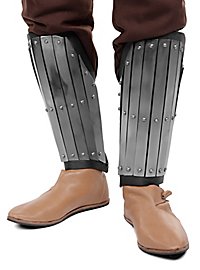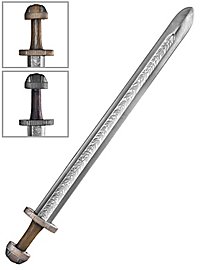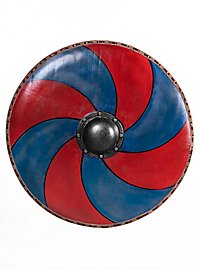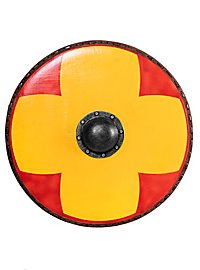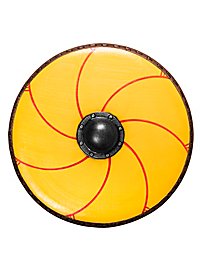Our Viking Shop - Everything for the People of the North
Our Viking Shop contains various items of equipment, such as traditional Viking jewellery, Viking clothing and Viking Larp weapons, such as the typical Viking axe and the round shield. But what is there to know about the legendary Scandinavian seafarers?
The Vikings were often referred to as barbarians, heathens, and savages. This was mainly due to the raids carried out by Vikings. Monasteries and villages were typical targets for Viking warriors' attacks, as they were usually civilian and mostly undefended. An incredible sacrilege on the part of the Christian church. There, the Vikings plundered food, cultural treasures, and women, abbots, and nuns, whom they then released for ransom or sold into slavery. Since the Vikings had a completely different belief system, they saw no problem in desecrating defenselessmonasteries. A situation that led to much hatred and lasting feuds between Christians and Vikings.
- Vikings and their ships! Brilliant seafarers!
The Vikings have also become famous for their shipbuilding. With their longships, they undertook unprecedented voyages of discovery, first to England and later even to the Orient via river routes. It was also the Vikings who discovered America before Columbus, according to some sources. It is even believed that they settled there for a while.
- Vikings and Celts are not the same!
The Vikings are often confused with the Celts or lumped together with them, although in terms of tribal history they appeared 800 years later and belong to the Germanic tribes. Only very few Celtic peoples existed at all at the time of the Vikings and it can be assumed that they had little contact. However, influences of Celtic peoples are so far-reaching that the Vikings could also have inherited parts of their culture in a roundabout way. Who knows for sure? Both the Vikings and the Celts were not exactly known for writing much down and thus leaving it to posterity.
Buy armor and Larp weapons for Vikings
A Viking warrior was often equipped with a sword, spear or Viking axe and the typical round shield as well as a Viking helmet, the so-called goggled helmet. A Viking sword had a broad long blade and a short parry hilt with a broad pommel. Viking swords were often reserved for the Jarls, i.e. the leaders of a Viking tribe. Viking armour was usually made of leather, or chain armour, and metal armour was seen but also rare. You can buy a Viking leather armor from us, but only very few models are suitable for authentic Viking portrayal. However, we have plenty of options suitable for fantasy Vikings in the style of HBO's Vikings. Our Viking armor made of PU is also interesting, perfect for LARP (Live Action Role-Playing) because they are much lighter than real metal Viking armor. Our Viking round shields for LARP are extremely realistic and beautifully decorated. Just buy the matching Viking axe, and you're ready to go into battle.
Viking clothing and the Viking costume. What's the difference?
A Viking costume for Carnival cannot be compared to authentic Viking garments. Viking clothing was diverse and not necessarily as depicted in movies or series. Often, Carnival Viking costumes have nothing to do with historical Viking attire. A plastic horned helmet, lots of fur, and faux leather, for example, are as far from Viking garb as anything could be. There's a misconception that Viking clothing was dirty, worn, and full of fur and leather. While leather and fur were indeed used by Vikings, they were crafted professionally, as technology allowed at that time.
- What makes a good outfit for Vikings?
Viking men wore fabric trousers, such as the Thorsberg trousers, and leg wraps. A typical Viking tunic consisted of two layers, a shirt and an underdress. These were usually cinched with a long Viking belt. Authentic Viking clothing was quite colorful and, depending on social status, elegantly decorated. A Viking jarl (chief) naturally looked different from a simple farmer. Brooches, metal jewelry, and amber jewelry were found among wealthy Viking men and women, but there was a variety of finely crafted Viking jewelry available. Gold jewelry was also common among Vikings and served as a status symbol. The Viking cloak is also a must, as it reliably protected against the harsh weather of Scandinavia.
Viking garments for women - What did the Viking woman look like?
Historically typical of Viking women's clothing were apron dresses, held in place by brooches and worn over a long, usually light-coloured undergarment. Amber necklaces as jewellery are also very authentic for Viking ladies. Typical of Viking women's garb was also the Birka cloak. This was held together with a usually round brooch and protected against cold weather. Historical finds from the Viking Age also show that wealthy Viking women's clothing included jewellery such as rings, bracelets and clasps. Viking women also wore woolen cloaks against wind and weather.
- The Shieldmaiden, warrioress of the North!
Viking women didn't only wear dresses by far. There were also shieldmaidens among the Vikings who wore the clothing and armor of men and went on raids and into battle. Shieldmaidens were naturally dressed for practicality, like men in Viking trousers and tunics. So, Viking women's clothing is very versatile, and the choice of clothing depends heavily on what kind of Viking woman one wants to portray. But whether as a shieldmaiden or authentic Viking garb for women, you'll find it here at Andracor.
Viking Gods and the beliefs of the Vikings
The Vikings worshipped a variety of gods and goddesses, including Odin, the mighty god of wisdom and war; Thor, the god of thunder and protector of humans, who has experienced a resurgence in popularity through the Marvel movies; and Freyja, the goddess of love and fertility. Other important deities included Loki, the trickster god, also an extremely popular film character since his appearance in the Marvel Universe, and Frigg, Odin's wife and goddess of marriage.
Norse mythology and the beliefs of the Vikings significantly influenced their daily lives and culture. To this day, the symbolism of Norse mythology remains popular and is worn in the form of Viking jewelry.
Many items in our online shop symbolically reference the gods of the Vikings. From amulets representing Odin's protection to Thor's hammer pendants symbolizing strength, these products reflect the rich mythological tradition of the Vikings. Such symbolism can also be found on Viking LARP weapons and armor.
The Larp Viking - Between Fantasy & History
The traces of the Vikings can be found very clearly in Larp Culture. Especially in jewellery, armour designs and weapon ornaments, you can find the influences of the Vikings in Larp. This is justified because Larp takes up many influences from the Middle Ages and earlier history, such as clothing, weapons and ranks, and brings them to life in the game. Runes from the Viking Age are also played with in Larp through riddles or coded texts. But also the Nordic traditions and the world of the Viking gods are played with by the players and some Larp-Events.
Vikings are therefore a typical feature in larp, whether inspired by historical events or fantastical. Larp Vikings try to bring a part of the culture and traditions of the Vikings into the game. Larp Vikings adorn themselves with characteristic jewellery and dress in typical Viking clothing. Influences of the Viking Age can be seen almost everywhere in Larp, be it in a belt buckle or a brooch. The Viking Age is a popular part of history and is therefore readily taken up and played with in Larp. However, many Larp Vikings try to behave as one would imagine a Viking to behave, not necessarily as they really were. This is quite different from Viking reenactment. However, as with all areas of larp, one's concept of one's character is important, and this may differ from typical clichés or historical context. If you want to buy equipment and Viking clothing, Andracor is definitely the online shop for you.

--302898-0a.jpg)

